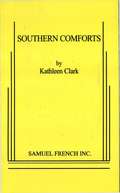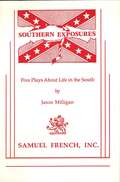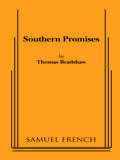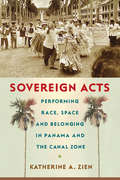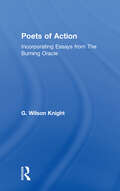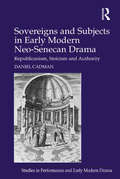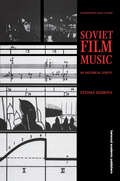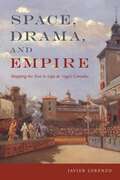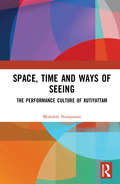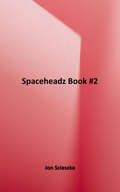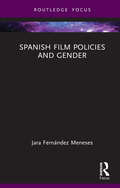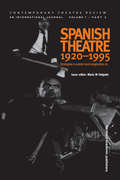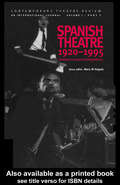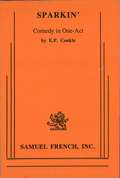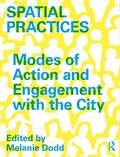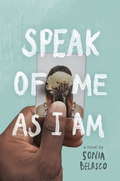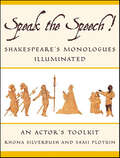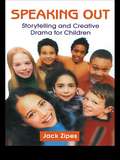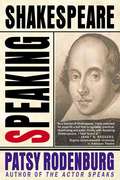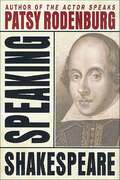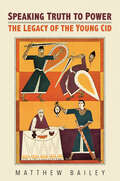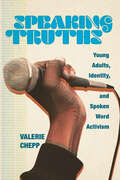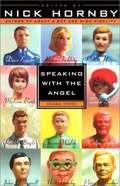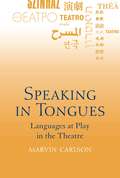- Table View
- List View
Southern Comforts
by Kathleen ClarkComedy / 1m, 1f / Interior / Some people need continuous change in order to feel vital and alive. Others are terrified of unsettling the peace that they have established. Two-time O'Neill Playwright's Conference participant Kathleen Clark uses her words to detail this tour-de-force journey of a widow and widower who meet later in life and find a way into each other's hearts. Southern Copmforts is a beautiful exploration of the intimate workings of all relationships. In a sprawling New Jersey Victorian, a taciturn Yankee widower and a vivacious grandmother from Tennessee find what they least expected - a second chance at love. Their funny, awkward, and enchanting romance is filled with sweet surprise and unpredictable tribulation. Told with warmth and perceptive humor, this off-Broadway success is an affecting, late-in-life journey of compromise and rejuvenation, of personal risk and the rewards of change.
Southern Promises
by Thomas BradshawDrama / Characters: 6m, 2f, with doubling / Simple Set / When the master of the plantation dies, he wills his slaves to be freed, but his wife doesn't think that good property should be squandered. Pandemonium ensues. The play is inspired by the true story of Henry Box Brown who escaped to the north by mailing himself in a box. Southern Promises provides a unique portrait of the old south. Bradshaw was named Playwright of the year by the theater blog KUL-That Sounds Cool and Southern Promises was named among the best performances of Stage and Screen for 2008 in The New Yorker. "Slowly, almost single-handedly, a twenty-eight-year-old black playwright named Thomas Bradshaw has been taking on the idea of race in the theatre. At the same time, he has sliced open the pretensions of the white avant-garde with a wittily glistening axe. In his new play, Southern Promises (at Performance Space 122), one can catch a glimpse of Bradshaw's anarchic gifts." -The New Yorker. "It's a striking, challenging piece that studies the abuse of power and the liquidity of morality." -NYTheatre.com. "Likely to leave you speechless"-The New York Times. "Thomas Bradshaw's deeply twisted, coolly brutal period drama Southern Promises" -Village Voice.
Sovereign Acts: Performing Race, Space, and Belonging in Panama and the Canal Zone
by Katherine A. ZienSovereign Acts explores how artists, activists, and audiences performed and interpreted sovereignty struggles in the Panama Canal Zone, from the Canal Zone’s inception in 1903 to its dissolution in 1999. In popular entertainments and patriotic pageants, opera concerts and national theatre, white U.S. citizens, West Indian laborers, and Panamanian artists and activists used performance as a way to assert their right to the Canal Zone and challenge the Zone’s sovereignty, laying claim to the Zone’s physical space and imagined terrain. By demonstrating the place of performance in the U.S. Empire’s legal landscape, Katherine A. Zien transforms our understanding of U.S. imperialism and its aftermath in the Panama Canal Zone and the larger U.S.-Caribbean world.
Sovereign Flower - Wilson Kni
by Wilson KnightFirst published in 2002. Routledge is an imprint of Taylor & Francis, an informa company.
Sovereigns and Subjects in Early Modern Neo-Senecan Drama: Republicanism, Stoicism and Authority (Studies In Performance And Early Modern Drama Ser.)
by Daniel CadmanSovereigns and Subjects in Early Modern Neo-Senecan Drama examines the development of neo-Senecan drama, also known as ’closet drama’, during the years 1590-1613. It is the first book-length study since 1924 to consider these plays - the dramatic works of Mary Sidney, Samuel Daniel, Samuel Brandon, Fulke Greville, Sir William Alexander, and Elizabeth Cary, along with the Roman tragedies of Ben Jonson and Thomas Kyd - as a coherent group. Daniel Cadman suggests these works interrogate the relations between sovereigns and subjects during the early modern period by engaging with the humanist discourses of republicanism and stoicism. Cadman argues that the texts under study probe various aspects of this dynamic and illuminate the ways in which stoicism and republicanism provide essential frameworks for negotiating this relationship between the marginalized courtier and the absolute sovereign. He demonstrates how aristocrats and courtiers, such as Sidney, Greville, Alexander, and Cary, were able to use the neo-Senecan form to consider aspects of their limited political agency under an absolute monarch, while others, such as Brandon and Daniel, respond to similarly marginalized positions within both political and patronage networks. In analyzing how these plays illuminate various aspects of early modern political culture, this book addresses several gaps in the scholarship of early modern drama and explores new contexts in relation to more familiar writers, as well as extending the critical debate to include hitherto neglected authors.
Soviet Film Music (Contemporary Music Studies)
by Tatiana EgorovaFirst Published in 1998. Routledge is an imprint of Taylor & Francis, an informa company.
Space, Drama, and Empire: Mapping the Past in Lope de Vega's Comedia (Campos Ibéricos: Bucknell Studies in Iberian Literatures and Cultures)
by Javier LorenzoSpanish poet, playwright, and novelist Félix Lope de Vega (1562–1635) was a key figure of Golden Age Spanish literature, second only in stature to Cervantes, and is considered the founder of Spain’s classical theater. In this rich and informative study, Javier Lorenzo investigates the symbolic use of space in Lope’s drama and its function as an ideological tool to promote an imagined Spanish national past. In specific plays, this book argues, historical landscapes and settings were used to foretell and legitimize the imperial present in Hapsburg Spain, allowing audiences to visualize and plot, as on a map, the country’s expansionist trajectory throughout the centuries. By focusing on connections among space, drama, and empire, this book makes an important contribution to the study of literature and imperialism in early modern Spain and equally to our understanding of the role and political significance of spatiality in Siglo de Oro comedia.
Space, Time and Ways of Seeing: The Performance Culture of Kutiyattam
by Mundoli NarayananThis volume explores the constitutive role played by space in the performance of Kutiyattam. The only surviving form of Sanskrit theatre, Kutiyattam is distinctive in terms of its performance conventions and its unique culture of extensive elaboration and interpretation. Drawing upon the concepts of phenomenology on the processes of perception, particularly on the works of Edmund Husserl, Martin Heidegger and Maurice Merleau-Ponty, it analyses the role of space in the communicative structures of performance of Kutiyattam and its contribution to the production of meaning in theatre, especially in the context of contemporary theatre. The book explores the theatrical event as a phenomenon that comes into existence through a triangular relationship among the ‘ways of being’ of the performers, the ‘ways of seeing’ of the audience, and the space which brings them together. Based on this formulation, Kutiyattam is approached as a ‘theatre of elaboration,’ made possible by the ‘intimate,’ ‘proximal’ ways of seeing of the audience, in the particular theatrical space of the kūttampalaṃs, the temple theatres, where Kutiyattam has customarily been performed for more than five centuries. This volume will be of great interest to scholars and researchers of cultural studies, theatre and performance studies, cultural anthropology, phenomenology and South Asian studies.
Spaceheadz Book #2! (Spaceheadz Ser. #2)
by Jon ScieszkaThe campaign to save the earth from being turned off is going well, but Michael K. must enlist fellow fifth-graders Venus and TJ to help hide the SPHDZ from Agent Umber, especially when they become involved in a school play.
Spanish Film Policies and Gender (Routledge Focus on Media and Cultural Studies)
by Jara Fernández MenesesThis book provides a comprehensive cultural and historical account of the key film policies put into place by the Spanish state between 1980 and 2010 through a gendered lens, framing these policies within the wider context of European film legislation.Departing from the belief that there is no such thing as an objective and value-neutral approach to policy analysis because our society is organised around gender, this volume builds upon Pierre Bourdieu’s theory of field to propose that film policies do not emerge in a vacuum because they respond to different demands from those agents involved in the field of the Spanish cinema. By so doing, it critically assesses how these policies have come into being, by whom, in response to what interests, how they have shaped the Spanish film industry, and how far and in what ways they have tackled gender inequality in the Spanish film industry.This book will be of great interest to scholars and students of Spanish cinema, gender studies, film industry studies, film policy, and feminist film studies.
Spanish Theatre 1920 - 1995: Strategies in Protest and Imagination (2) (Contemporary Theatre Review Ser. #Vols. 7, Pts. 4)
by Maria M DelgadoBeginning with a reassessment of the 1920s and 30s, this text looks beyond a consideration of just the most successful Spanish playwrights of the time, and discusses also the work of directors, theorists, actors and designers.
Spanish Theatre 1920-1995: Strategies in Protest and Imagination (1) (Contemporary Theatre Review Ser. #Vols. 7, Pts. 4)
by Maria M. DelgadoBeginning with a reassessment of the 1920s and 30s, this text looks beyond a consideration of just the most successful Spanish playwrights of the time, and discusses also the work of directors, theorists, actors and designers.
Sparkin'
by E. P. ConkleComedy / 1m, 3f / This is a delightful little comedy of small town Nebraska people and has to do with a timid young man who goes courting, but is unable to come to the point until Granny teaches him how to become a man.
Sparkles, No Sparkles
by Shannon McNeillAdorable animals go for a glittering night at the theater in this hilarious picture book, a perfect read-aloud tale for very young readers.A frog has no sparkle.A poodle has no sparkle.A pigeon has no sparkle.Not to worry! A cape has sparkle, a crown has sparkle and boots have sparkle.Some wily animals decide to hit the stage, leaving the actors without costumes. After the animals get their moment in the spotlight, chaos ensues . . . but luckily there are some chicks with sparkle to save the day.
Spatial Practices: Modes of Action and Engagement with the City
by Melanie DoddThis book explores ‘spatial practices’, a loose and expandable set of approaches that embrace the political and the activist, the performative and the curatorial, the architectural and the urban. Acting upon and engaging with the public realm, the field of spatial practices allows people to reconnect with their own sense of agency through engagement in space and place, exploring and prototyping alternative futures in the here and now. The 24 chapters contain essays, visual essays and interviews, featuring contributions from an international set of experimental practitioners including Jeanne van Heeswijk (Netherlands), Teddy Cruz (Estudio Teddy Cruz + Fonna Forman, San Diego), Hector (USA), The Decorators (London) and OOZE (Netherlands). Beautifully designed with full colour illustrations, Spatial Practices advances dialogue and collaboration between academics and practitioners and is essential reading for students, researchers and professionals in architecture, urban planning and urban policy.
Speak of Me As I Am
by Sonia BelascoA moving story of grief, honesty, and the healing power of art — the ties that bind us together, even when those we love are gone.Melanie and Damon are both living in the shadow of loss. For Melanie, it's the loss of her larger-than-life artist mother, taken by cancer well before her time. For Damon, it’s the loss of his best friend, Carlos, who took his own life. As they struggle to fill the empty spaces their loved ones left behind, fate conspires to bring them together. Damon takes pictures with Carlos’s camera to try to understand his choices, and Melanie begins painting as a way of feeling closer to her mother. But when the two join their school’s production of Othello, the play they both hoped would be a distraction becomes a test of who they truly are, both together and on their own. And more than anything else, they discover that it just might be possible to live their lives without completely letting go of their sadness.Praise for Speak of Me As I Am:"Debut author Belasco adeptly captures the tribulations of high school life while also celebrating art's ability to help clarify and contextualize its joys and sorrows. . . . The novel's most intriguing character . . . is grief itself, which the author illuminates, examines, and dissects with a surgeon's precision and the gentle touch of an artist. A stirring account of the trials of adolescence." —Kirkus Reviews"A good purchase for realistic fiction collections and for readers looking for books about survivor’s guilt and healing." —School Library Journal "This book will undoubtedly be compared to Rainbow Rowell’s Eleanor & Park. . . . Teens seeking a quieter but no less moving story will find this book a perfect read." —Booklist
Speak the Speech!: Shakespeare's Monologues Illuminated: An Actor's Toolkit
by Rhona Silverbush Sami PlotkinThe most comprehensive sourcebook of Shakespeare's monologues ever available in one volume.A detailed guide to approaching Shakespearean text, Speak the Speech! contains everything an actor needs to select and prepare a Shakespeare monologue for classwork, auditions, or performance. Included herein are over 150 monologues. Each one is placed in context with a brief introduction, is carefully punctuated in the manner that best illustrates its meaning, and is painstakingly and thoroughly annotated. Each is also accompanied by commentary that will spark the actor's imagination by exploring how the interrelationship of meter and the choice of words and sounds yields clues to character and performance. And throughout the book sidebars relate historical, topical, technical, and other useful and entertaining information relevant to the text. In addition, the authors include an overview of poetic and rhetorical elements, brief synopses of all the plays, and a comprehensive index along with other guidelines that will help readers locate the perfect monologue for their needs.More than just an actor's toolkit, Speak the Speech! is also an entertaining resource that will help demystify Shakespeare's language for the student and theater lover alike.
Speaking Out: Storytelling and Creative Drama for Children
by Jack ZipesIn his successful Creative Storytelling, Jack Zipes showed how storytelling is a rich and powerful tool for self-expression and for building children's imaginations. In Speaking Out, this master storyteller goes further, speaking out against rote learning and testing and for the positive force within storytelling and creative drama during the K-12 years.For the past four years, Jack Zipes has worked with the Neighborhood Bridges Program of the Children's Theatre Company of Minneapolis, taking his storytelling techniques into inner-city schools. Speaking Out is in part a record of the transformations storytelling can work on the minds and lives of young people. But it is also a vivid and exhilarating demonstration of a different kind of education - one built from deep inside each child. Speaking Out is a book for storytellers, educators, parents, and anyone who cares about helping kids find within themselves the keys to imagination.
Speaking Shakespeare
by Patsy RodenburgPatsy Rodenburg tackles one of the most difficult acting jobs: speaking Shakespeare's words both as they were meant to be spoken and in an understandable and dramatic way. Rodenburg calls this "a simple manual to start the journey into the heart of Shakespeare," and that is what she gives us. With the same insight she displayed in The Actor Speaks, Rodenburg tackles the playing of all Shakespeare's characters. She uses dramatic resonance, breathing, and placement to show how an actor can bring Hamlet, Rosalind, Puck and other characters to life. This is one book every working actor must have.
Speaking Shakespeare
by Patsy RodenburgIn Speaking Shakespeare, Patsy Rodenburg tackles one of the most difficult acting jobs: speaking Shakespeare's words both as they were meant to be spoken and in an understandable and dramatic way. Rodenburg calls this "a simple manual to start the journey into the heart of Shakespeare," and that is what she gives us. With the same insight she displayed in The Actor Speaks, Rodenburg tackles the playing of all Shakespeare's characters. She uses dramatic resonance, breathing, and placement to show how an actor can bring Hamlet, Rosalind, Puck and other characters to life. This is one book every working actor must have.
Speaking Truth to Power: The Legacy of the Young Cid (Toronto Iberic #86)
by Matthew BaileyEmerging from a richly diverse oral narrative tradition, the heroic tale of the young Cid appears in multiple textual manifestations. From its first appearance circa 1300, the dynamic narrative of the legendary deeds of this young Castilian warrior eclipses the uninspired, matter-of-fact narration of the reign of Fernando I into which it is incorporated. In its analysis of the Mocedades de Rodrigo, the epic poem of Cid’s youth, Speaking Truth to Power identifies the narrative cohesion and the aesthetic principles that elevated the story of the young Cid to its place of prominence among the epic narratives of medieval Spain. Examining the evolution of the narrative through various textual versions, Matthew Bailey highlights the permutations that propelled the young Cid’s unparalleled popularity. The book traces this vibrant narrative tradition from its earliest manifestation in the aftermath of Charlemagne’s imperial mission in Spain to the early modern drama of Guillén de Castro. It convincingly discerns the leadership qualities and the social impact of its legendary protagonists, from their manifestation in the Latin chronicles of early Iberia through the Renaissance, incorporating a wealth of previous scholarship in its innovative findings. Speaking Truth to Power provides readers with a heightened appreciation for the vibrancy of the poetic tradition that lives beyond the texts we study, the oral narratives that are continually refashioned for new audiences and contexts.
Speaking Truths: Young Adults, Identity, and Spoken Word Activism
by Valerie CheppThe twenty-first century is already riddled with protests demanding social justice, and in every instance, young people are leading the charge. But in addition to protesters who take to the streets with handmade placards are young adults who engage in less obvious change-making tactics. In Speaking Truths, sociologist Valerie Chepp goes behind-the-scenes to uncover how spoken word poetry—and young people’s participation in it—contributes to a broader understanding of contemporary social justice activism, including this generation’s attention to the political importance of identity, well-being, and love. Drawing upon detailed observations and in-depth interviews, Chepp tells the story of a diverse group of young adults from Washington, D.C. who use spoken word to create a more just and equitable world. Outlining the contours of this approach, she interrogates spoken word activism’s emphasis on personal storytelling and “truth,” the strategic uses of aesthetics and emotions to politically engage across difference, and the significance of healing in sustainable movements for change. Weaving together their poetry and personally told stories, Chepp shows how poets tap into the beautiful, emotional, personal, and therapeutic features of spoken word to empathically connect with others, advance intersectional and systemic analyses of inequality, and make social justice messages relatable across a diverse public. By creating allies and forging connections based on friendship, professional commitments, lived experiences, emotions, artistic kinship, and political views, this activist approach is highly integrated into the everyday lives of its practitioners, online and face-to-face. Chepp argues that spoken word activism is a product of, and a call to action against, the neoliberal era in which poets have come of age, characterized by widening structural inequalities and increasing economic and social vulnerability. She illustrates how this deeply personal and intimate activist approach borrows from, builds upon, and diverges from previous social movement paradigms. Spotlighting the complexity and mutual influence of modern-day activism and the world in which it unfolds, Speaking Truths contributes to our understanding of contemporary social change-making and how neoliberalism has shaped this political generation’s experiences with social injustice.
Speaking With The Angel
by Nick HornbyNick Hornby. . . Giles Smith. . . Helen Fielding. . . Roddy Doyle. . . Irvine Welsh. . . Zadie Smith. . . Dave Eggers. . . Robert Harris. . . Melissa Bank. . . Patrick Marber. . . Colin Firth. . . John O'Farrell Compiled by bestselling author Nick Hornby and featuring brand new stories from the hottest writers on both sides of the Atlantic, Speaking with the Angel is a fresh and funny collection that is sure to be the literary anthology of the year. Here is a book that was inspired by a very special boy and a very special school. Some money from each copy of Speaking with the Angel sold will benefit autism education charities around the world, including The Treehouse School in London, where Nick's son Danny is a student, and the New York Child Learning Institute here in the States. This project is truly a labor of love for Hornby and the other writers involved, many of whom are Nick's friends. These original first-person narratives come from the most exciting voices in fiction. Melissa Bank gives readers a glimpse into the mind of a modern New Yorker whose still-new relationship is a constant source of surprise in "The Wonder Spot. " In Zadie Smith's "I'm the Only One," a young man recalls his strained relationship with his diva-esque sister. Dave Egger's "After I Was Thrown in the River and Before I Drowned," is told from the viewpoint of an unfortunate pit bull. Helen Fielding offers up a new twist on I've fallen and I can't get up in "Luckybitch. " And in Nick Hornby's "NippleJesus," a bruiser finds out that guarding modern art is far more hazardous than controlling the velvet ropes at a nightclub. Speaking with the Angel also includes stories from Roddy Doyle, Irvine Welsh, Colin Firth, John O'Farrell, Robert Harris, Patrick Marber, and Giles Smith. Twelve completely new stories, written by twelve undeniably imaginative voices. Speaking with the Angel is at turns clever, outrageous, witty, edgy, tender, and wicked. This is what they meant by original.
Speaking in Tongues: Languages at Play in the Theatre
by Marvin CarlsonCarlson (theater and comparative literature, City U. of New York--Graduate Center) suggests how linguistic theory and theater practice at the close of the 20th century challenge conventional thinking about theatrical language and the various ways that language can function in the theater. The macaronic stage, post-colonial heteroglossia, and post-modern language play are among his perspectives. Annotation ©2006 Book News, Inc., Portland, OR (booknews.com)
